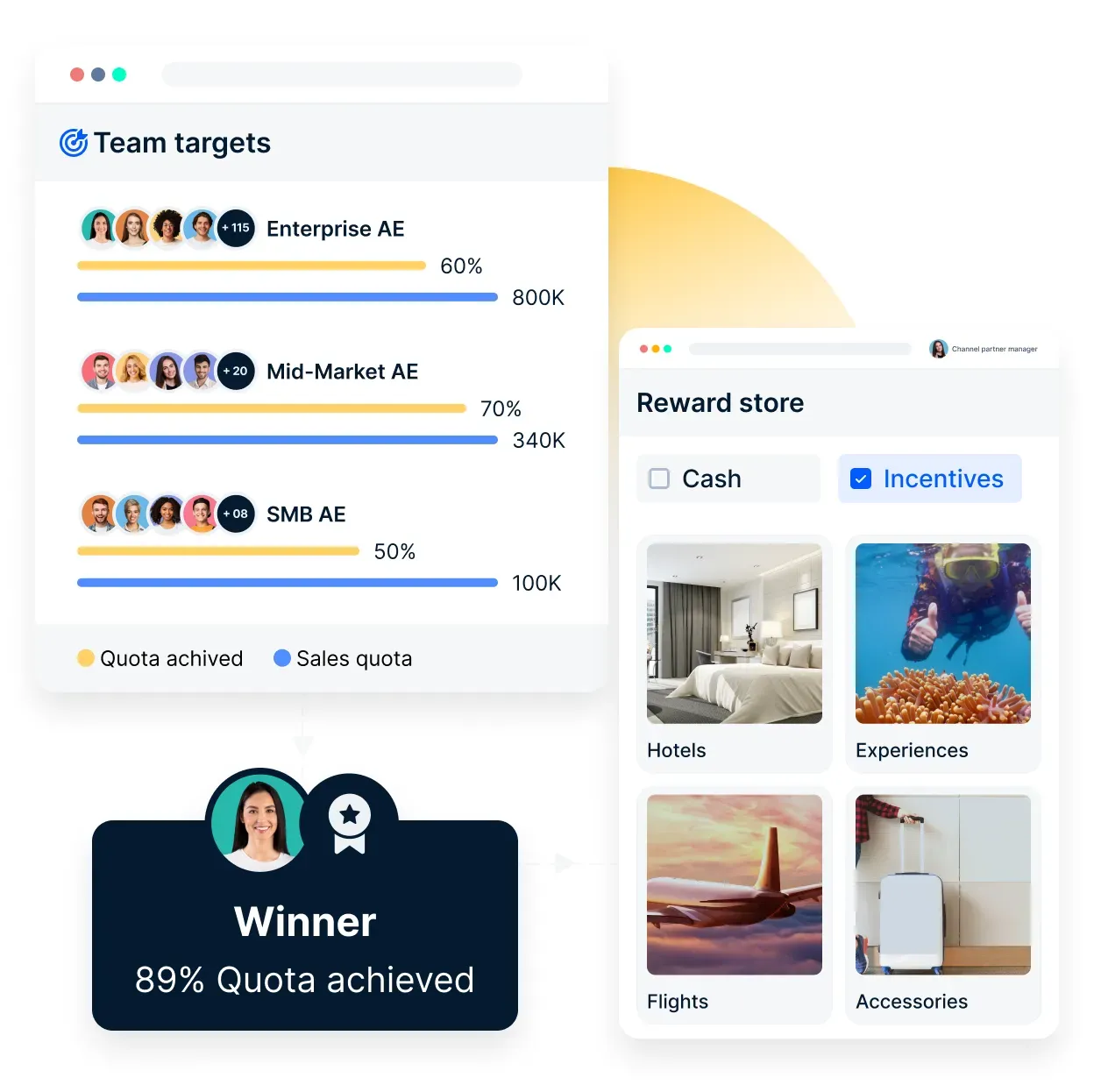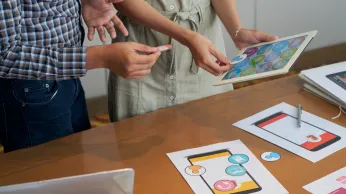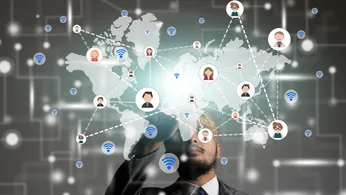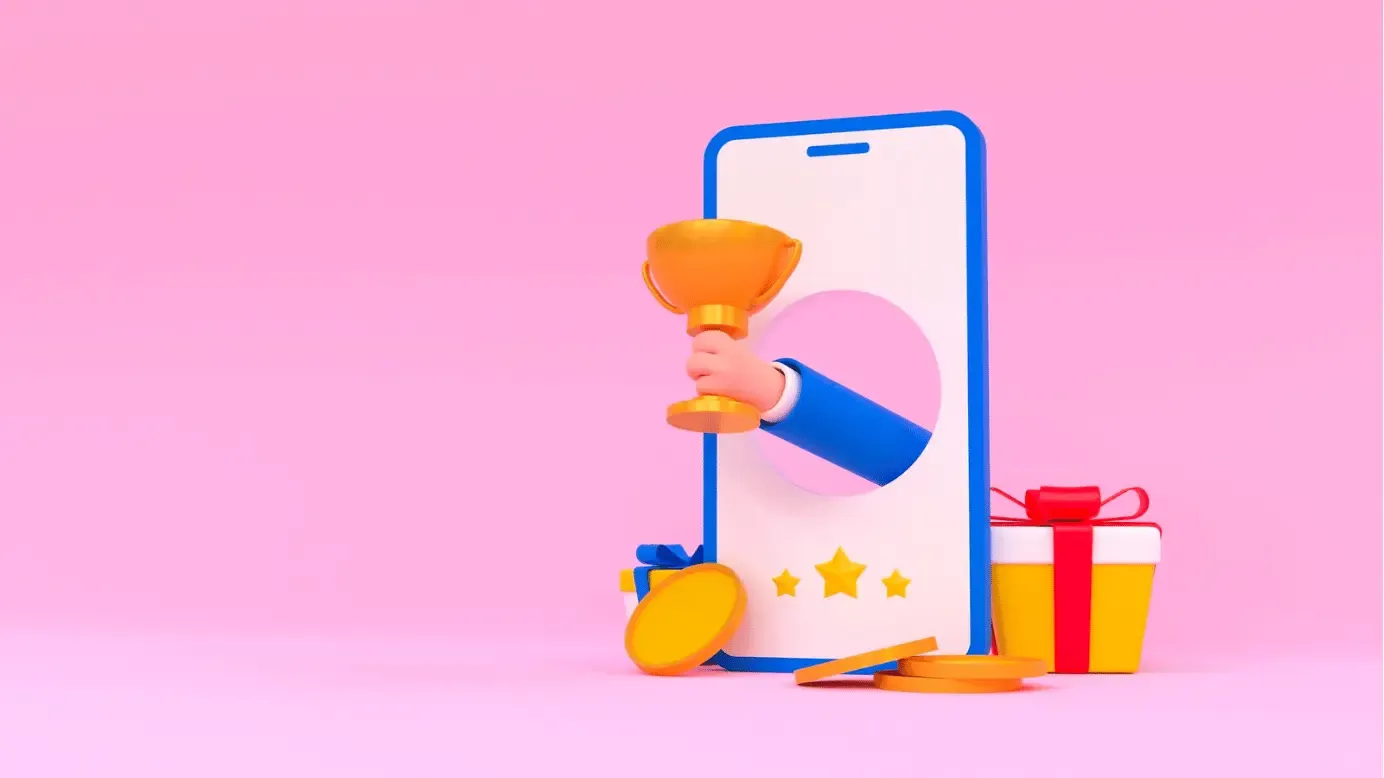12 Idea Gamifikasi Jualan untuk Pasukan Mencapai Matlamat Perniagaan Anda
12 idea gamifikasi jualan yang akan memberi tenaga kepada pasukan jualan anda dan meningkatkan motivasi. Ketahui cara gamifikasi untuk pasukan jualan membantu meningkatkan prestasi jualan.
Pada halaman ini
Jualan selalunya boleh menjadi bidang yang mencabar dan kompetitif, dan mencari cara untuk memotivasi dan melibatkan pasukan jualan anda boleh memberi kesan ketara kepada prestasi mereka. Satu pendekatan yang berkesan ialah memasukkan gamifikasi ke dalam proses jualan anda.
Menerapkan elemen permainan dan mekanik untuk aktiviti jualan mewujudkan persekitaran yang menyeronokkan dan kompetitif yang mendorong motivasi, kerjasama, dan peningkatan produktiviti.
Blog ini akan meneroka 12 idea gamifikasi jualan untuk membantu anda meningkatkan prestasi pasukan jualan anda.
12 Idea gamifikasi jualan kreatif untuk mencapai matlamat perniagaan anda
Berikut ialah 12 idea gamifikasi jualan untuk meningkatkan prestasi jualan dan mencapai matlamat perniagaan anda.
1. Papan pendahulu dan pertandingan
Salah satu cara yang paling mudah dan berkesan untuk memperkenalkan gamifikasi ke dalam proses jualan anda ialah melalui papan pendahulu dan pertandingan . Cipta perwakilan visual prestasi jualan pasukan anda dan paparkannya dengan jelas di pejabat anda atau pada platform digital yang dikongsi .
Tetapkan matlamat yang jelas dan beri ganjaran kepada pemain terbaik dengan insentif atau pengiktirafan. Pendekatan ini memupuk persaingan yang sihat, menggalakkan ahli pasukan untuk mendorong diri mereka, dan mewujudkan rasa pencapaian.
2. Lencana dan ganjaran
Pencapaian yang bermanfaat dengan lencana atau ganjaran maya boleh memberikan motivasi tambahan untuk pasukan jualan anda. Cipta sistem di mana ahli pasukan boleh mendapatkan lencana atau mata untuk menyelesaikan tugas tertentu atau mencapai pencapaian jualan.
Lencana ini boleh mewakili pelbagai pencapaian, seperti menutup perjanjian bernilai tinggi, mencapai sasaran jualan, atau menunjukkan kerja berpasukan yang luar biasa. Apabila ahli pasukan mengumpul lencana, mereka boleh membuka kunci ganjaran atau insentif tambahan, memupuk rasa kemajuan dan pencapaian.
3. Simulasi jualan dan peranan
Simulasi jualan dan latihan peranan menawarkan peluang yang berharga bagi pasukan anda untuk mengamalkan kemahiran mereka dalam persekitaran yang selamat dan terkawal. Buat senario yang meniru situasi jualan kehidupan sebenar dan berikan peranan yang berbeza kepada ahli pasukan.
Galakkan mereka untuk meneroka pendekatan dan teknik yang berbeza untuk mengatasi bantahan, mengendalikan pelanggan yang sukar, atau merundingkan tawaran. Dengan menggabungkan elemen persaingan dan memberikan maklum balas yang membina, anda boleh membantu pasukan anda mengembangkan kemahiran jualan mereka sambil menjadikan proses pembelajaran menarik dan menyeronokkan.
4. Cabaran kolaboratif
Gamifikasi jualan tidak perlu dihadkan kepada prestasi individu. Memupuk kerjasama dan kerja berpasukan dengan memperkenalkan cabaran yang memerlukan usaha kolektif. Sebagai contoh, tetapkan sasaran pasukan untuk tempoh tertentu dan beri ganjaran kepada semua orang apabila matlamat dicapai.
Sebagai alternatif, anda boleh mencipta cabaran berasaskan pasukan di mana individu menyumbang kepada matlamat bersama. Pendekatan ini bukan sahaja menggalakkan kerjasama tetapi juga membina keakraban di kalangan ahli pasukan, yang membawa kepada persekitaran kerja yang lebih positif dan menyokong.
5. Permainan latihan jualan
Latihan jualan tradisional selalunya boleh membosankan dan tidak memberi inspirasi. Menyuntik elemen gamifikasi ke dalam program latihan anda boleh menjadikannya lebih menarik dan mudah diingati. Bangunkan permainan latihan jualan interaktif yang mensimulasikan senario dunia sebenar dan memberikan maklum balas segera.
Permainan ini boleh merangkumi pelbagai aspek, seperti pengetahuan produk, pengendalian bantahan, atau teknik jualan. Anda boleh meningkatkan pengekalan maklumat dan aplikasi dengan menjadikan proses latihan menyeronokkan, yang membawa kepada strategi jualan yang lebih berkesan.
6. Cabaran pasukan dengan kemas kini masa nyata
Buat cabaran terikat masa yang memerlukan pasukan bekerjasama untuk mencapai matlamat tertentu. Sebagai contoh, anda boleh menetapkan sasaran untuk bilangan panggilan jualan tertinggi yang dibuat secara kolektif atau jumlah hasil yang dijana dalam tempoh tertentu. Berikan kemas kini masa nyata dan penjejakan kemajuan, supaya pasukan dapat melihat prestasi mereka berbanding yang lain. Ini menggalakkan persaingan yang sihat, mendorong kerja berpasukan, dan menambah keseronokan kepada aktiviti jualan harian.
7. Bingo jualan
Buat kad bingo jualan dengan tugas atau pencapaian berkaitan penjualan yang berbeza di setiap dataran. Tugas boleh termasuk aktiviti seperti menutup perjanjian dalam jangka masa tertentu, menjual produk tertentu, atau mendapatkan mesyuarat dengan prospek utama.
Apabila ahli pasukan menyelesaikan tugas, mereka menandakan petak yang sepadan. Orang pertama yang melengkapkan baris atau keseluruhan kad memenangi hadiah. Bingo jualan menambah elemen kejutan dan menggalakkan wakil untuk mempelbagaikan usaha jualan mereka.
8. Kuiz latihan jualan gamified
Ubah latihan jualan kepada pengalaman interaktif dan berdaya saing dengan menggabungkan kuiz gamified. Gunakan sistem pengurusan pembelajaran atau platform kuiz untuk membuat kuiz yang menarik berkaitan dengan pengetahuan produk, teknik jualan atau aliran industri.
Sertakan papan pendahulu jualan untuk memaparkan prestasi terbaik dan memberi ganjaran kepada mereka yang secara konsisten menunjukkan pengetahuan dan kemahiran yang kukuh. Pendekatan ini menggalakkan pembelajaran berterusan dan membantu mengukuhkan maklumat penting.
9. Liga jualan fantasi
Diilhamkan oleh liga sukan fantasi, cipta liga jualan fantasi di mana peserta membina pasukan maya menggunakan wakil jualan sebenar. Berikan nilai mata kepada metrik jualan yang berbeza, seperti pendapatan yang dijana, tawaran ditutup, atau petunjuk baru yang dihasilkan.
Peserta memperoleh mata berdasarkan prestasi wakil pilihan mereka dalam kehidupan sebenar. Konsep gamifikasi ini menggalakkan peserta untuk menganalisis data jualan, menyusun strategi, dan memilih wakil berprestasi tinggi untuk memaksimumkan kejayaan pasukan maya mereka.
10. Bilik melarikan diri jualan
Aturkan cabaran bilik melarikan diri bertemakan jualan untuk pasukan anda. Buat senario di mana ahli pasukan mesti bekerjasama untuk menyelesaikan teka-teki, mencari petunjuk dan membuka cabaran berkaitan jualan dalam had masa. Menggabungkan senario jualan ke dalam teka-teki, seperti berunding dengan prospek yang sukar atau mengenal pasti peluang upsell.
Pengalaman yang mengasyikkan menggalakkan kerja berpasukan, pemikiran kritis dan kemahiran menyelesaikan masalah sambil menambahkan unsur keseronokan dan persaingan yang mesra .
11. Lelongan jualan
Ubah sasaran jualan anda menjadi permainan gaya lelongan yang menarik. Berikan setiap sasaran jualan atau matlamat sistem nilai atau titik tertentu. Apabila ahli pasukan jualan anda mencapai sasaran mereka, mereka memperoleh mata.
Mengadakan lelongan jualan secara berkala di mana ahli pasukan boleh membida ganjaran atau insentif menggunakan mata yang mereka perolehi. Idea gamifikasi ini menambah kelainan kompetitif sambil membolehkan individu memilih ganjaran yang paling memotivasikan mereka.
12. Pencarian kolaboratif
Buat usaha kolaboratif yang memerlukan ahli pasukan bekerjasama ke arah objektif yang sama. Pecahkan matlamat jualan yang lebih besar kepada pencapaian atau tugas yang lebih kecil dan berikannya kepada ahli pasukan yang berbeza.
Setiap tugas yang lengkap menyumbang kepada pencarian keseluruhan. Apabila pasukan melengkapkan pencapaian, mereka membuka cabaran atau ganjaran baru. Pendekatan gamifikasi ini menggalakkan kerja berpasukan, menggalakkan perkongsian pengetahuan, dan membina rasa perpaduan dan pencapaian bersama.
Gamification dalam jualan berfungsi paling baik apabila ia sejajar dengan matlamat pasukan anda dan memupuk persekitaran yang positif dan menyokong. Jadilah kreatif, sesuaikan idea ini agar sesuai dengan dinamik pasukan anda, dan dapatkan maklum balas secara berkala untuk terus meningkatkan inisiatif gamifikasi jualan anda.
5 Strategi gamifikasi jualan untuk meningkatkan prestasi jualan
Pasukan jualan anda yang bercita-cita tinggi dan berdaya saing mungkin mempunyai ahli pasukan yang kebanyakannya suka bersaing antara satu sama lain. Sebaliknya, orang lain mungkin lebih suka bersaing dengan diri mereka sendiri. Tetapi satu perkara biasa di sini ialah kedua-dua jenis ahli pasukan ini menginginkan pertumbuhan.
Gamifikasi jualan membolehkan anda memotivasikan kedua-dua jenis dengan menyediakan persekitaran luaran untuk menyokong tingkah laku ini. Ia menggabungkan pendorong ekstrinsik (keinginan untuk menjadi lebih baik jika dibandingkan) dan intrinsik (keinginan untuk meningkatkan set kemahiran anda) dalam sistem ganjaran, dengan itu mendorong tingkah laku yang menyokong objektif perniagaan.
Gamifikasi jualan menjadikan kerja itu menyeronokkan. Ini menghasilkan kerja yang lebih banyak dan lebih baik, justeru meningkatkan prestasi . Tanpa pekerja menyedarinya secara langsung, gamifikasi proses jualan mengubah peraturan penglibatan, dan pekerja mengubah tingkah laku mereka. Ia meningkatkan keupayaan wakil jualan yang dilihat dengan menjadikan tugas yang sukar lebih mudah melalui latihan atau dengan mengurangkan ambang pengaktifan tingkah laku yang disasarkan untuk menyelesaikan tugas itu.
Tidak syak lagi bahawa gamifikasi jualan memainkan peranan penting dalam meningkatkan produktiviti dan motivasi keseluruhan, tetapi keberkesanannya dalam mana-mana organisasi bergantung kepada pelaksanaan yang berjaya.
Pertama, anda perlu mengenal pasti langkah-langkah dalam proses jualan anda yang penting dalam meningkatkan angka tetapi tidak mendapat perhatian yang cukup daripada wakil jualan. Ini adalah langkah utama yang anda perlukan untuk membina elemen gamifikasi anda.
Berikut adalah 5 idea gamifikasi jualan yang berkesan untuk meningkatkan prestasi jualan yang juga akan membantu anda meningkatkan jumlah jualan anda dan memastikan pasukan jualan anda bekerjasama seiring:
1. Terus meningkatkan intensiti ganjaran apabila tahap naik
Neurosains mengatakan bahawa ganjaran mencetuskan pelepasan dopamin dan tahap ganjaran yang sama dari masa ke masa menyebabkan pelepasan dopamin yang lebih rendah kerana kebiasaan. Semakin banyak cabaran dan ganjaran yang lebih tinggi atau tidak diketahui yang anda sampaikan kepada pasukan anda apabila tahap kemajuan, semakin besar pelepasan dopamin. Oleh itu, mereka akan lebih bermotivasi dan terus mengambil bahagian dan mencuba matlamat yang lebih tinggi.
2. Selaraskan ganjaran dengan matlamat organisasi
Tiada siapa yang berminat dengan filem dengan drama yang kurang dan tiada plot. Begitu juga dengan sistem ganjaran anda. Jika anda memulakan pertandingan dengan sedikit logik, ganjaran asas untuk menjaringkan tinggi dalam aktiviti rawak, dan memulakan persaingan gamified tanpa visi yang jelas, anda tidak boleh memastikan pasukan jualan bermotivasi terlalu lama.
Sebaliknya, jika anda membuat sistem ganjaran berasaskan titik sejajar dengan matlamat organisasi yang lebih besar dan aktiviti harian, yang perlu dilakukan oleh wakil jualan, pasukan jualan anda akan mengejar ganjaran kerana mereka akan dapat melihat dengan jelas bagaimana kemenangan dalam permainan juga membolehkan mereka menandakan item yang diperlukan dalam senarai tugasan harian mereka.
Anda mungkin termasuk memasukkan data petunjuk, peringkat mesyuarat pelanggan, penjualan, prospek, dan lain-lain, dalam ganjaran yang semakin meningkat untuk menyelesaikan setiap langkah.
3. Galakkan harga diri
Apabila gamification membolehkan papan pendahulu visual menunjukkan kedudukan pekerja berbanding ahli pasukan lain dan kandungan boleh kongsi mesra media sosial untuk memenangi cabaran. Pada masa yang sama, anda menyokong pasukan dengan meraikan kemenangan kecil; Rasa harga diri ahli pasukan diperkuatkan. Ini membantu mendorong pasukan jualan anda yang sudah bermotivasi untuk mencapai matlamat seterusnya dan menerapkan semangat berpasukan yang positif.
4. Papan pemuka masa nyata
Dunia semakin bergerak ke arah dinamisme. Sudah berlalu hari-hari rancangan berasaskan hamparan, graf mudah, dan carta dengan sedikit atau tiada penglibatan. Papan pemuka jualan gamified membolehkan wakil jualan anda melihat KPI, baki sasaran, dan bonus dalam cahaya baharu sebagai tahap untuk membuka kunci lencana untuk memperoleh, memenangi sekutu, atau memperkasakan avatar permainan mereka, dan lain-lain, dengan itu meningkatkan penglibatan dengan keseluruhan proses jualan.
5. Menggunakan alat gamifikasi jualan
Petua Haninger adalah untuk mengukur metrik gamifikasi dan menghasilkan sistem automatik yang tepat. "Anda perlu gunakan... sesuatu yang dianalisis secara automatik," kata Haninger.
Alat gamifikasi bukan hanya untuk keseronokan; ia adalah cara untuk meningkatkan prestasi dan meningkatkan penukaran sambil turut membantu anda mengumpul data berharga yang boleh anda gunakan untuk meningkatkan proses jualan dan pemasaran anda pada masa hadapan. Alat gamifikasi jualan boleh membantu anda mengendalikan prestasi jualan syarikat anda dengan lebih baik dan membantu anda mengukur metrik gamifikasi seperti bilangan orang yang bermain bersama peraduan jualan anda atau bilangan permainan yang dimainkan.
Syarikat e-dagang terkemuka menghadapi cabaran dalam menjejak prestasi pasukan audit merentas pelbagai kategori, termasuk pengurusan risiko penipuan, pemerolehan dan keselamatan rangkaian. Laporan dibuat secara manual, kekurangan cerapan masa nyata dan memberikan sedikit keterlihatan kepada pencapaian individu—membawa kepada motivasi rendah dalam kalangan ahli pasukan.
Untuk menangani isu-isu ini, syarikat melaksanakan Compass , perisian gamifikasi jualan yang teguh, untuk menyelaraskan penjejakan dan penglibatan prestasi. Platform ini memperkenalkan papan pemuka masa nyata, lencana berasaskan peristiwa penting, dan pengagihan mata insentif automatik, memberikan pasukan audit gambaran yang jelas tentang kemajuan dan ganjaran mereka.
Kesannya adalah ketara: penggunaan program insentif meningkat sebanyak 80% dalam masa 30 hari sahaja, manakala kepimpinan memperoleh gambaran yang disatukan dan grafik prestasi pasukan. Penyelesaian itu juga mengurangkan overhed pentadbiran, mewujudkan tenaga kerja yang lebih cekap dan bermotivasi. Kes ini menyerlahkan cara alat gamifikasi jualan boleh meningkatkan penglibatan, produktiviti dan hasil perniagaan merentas industri.
Kajian kes adalah jelas tentang cara gamifikasi boleh menjejak pasukan jualan anda dengan pantas ke arah kejayaan.
Bagaimana untuk gamify tempat kerja anda?
Gamifikasi di tempat kerja lebih daripada sekadar keseronokan dan permainan; ia merupakan pendekatan strategik untuk meningkatkan penglibatan dan produktiviti. Begini cara anda boleh menyepadukan gamifikasi jualan dan gamifikasi tempat kerja dengan berkesan:
1. Tetapkan matlamat yang jelas
Tentukan objektif anda sebelum melaksanakan gamifikasi untuk jualan. Selaraskan strategi gamifikasi dengan hasil perniagaan utama dan pastikan ketelusan supaya pekerja memahami tujuan dan ganjaran.
2. Wujudkan peraturan dan proses
Semua permainan insentif jualan dan cabaran tempat kerja memerlukan peraturan yang jelas. Nyatakan dengan jelas kriteria untuk menang, garis panduan kelayakan dan struktur ganjaran untuk memastikan persaingan yang adil.
3. Mula mudah
Memperkenalkan idea gamifikasi yang mudah difahami untuk pasukan jualan untuk menguji penglibatan. Cabaran jangka pendek, seperti "penukaran jualan mingguan tertinggi" atau "kebanyakan mesyuarat pelanggan ditempah," menawarkan kemenangan pantas sambil memupuk motivasi.
4. Tawarkan ganjaran yang bermakna
Gamifikasi pasukan yang berjaya bergantung pada insentif yang menarik. Gabungan pengiktirafan, ganjaran kewangan dan faedah pengalaman boleh mendorong penyertaan. Pertimbangkan ganjaran khusus jualan dalam program gamifikasi untuk menggalakkan pembangunan kemahiran.
5. Jejaki dan pantau kemajuan
Gunakan papan pemuka, maklum balas tinjauan atau perisian gamifikasi jualan seperti Compass untuk mengukur prestasi. Nilaikan sama ada strategi gamifikasi meningkatkan motivasi, produktiviti dan penjajaran dengan matlamat syarikat.
6. Manfaatkan cerapan data
Perniagaan moden bergantung pada data dan strategi boleh menjana cerapan berguna. Dengan menjejaki penyertaan dan penglibatan, anda boleh memperhalusi idea gamifikasi untuk jualan bagi memaksimumkan impak.
7. Pastikan ia segar
Untuk mengekalkan penglibatan, kembangkan idea gamifikasi anda dari semasa ke semasa. Tukar tahap kesukaran, perkenalkan cabaran baharu atau tukar idea untuk memastikan pekerja bermotivasi.
Mengintegrasikan gamifikasi pasukan jualan ke tempat kerja anda bukan sahaja memacu prestasi tetapi juga mewujudkan budaya pembelajaran dan penglibatan berterusan. Mulakan dengan idea gamifikasi ini untuk pasukan jualan dan saksikan produktiviti tempat kerja anda melonjak!
Gamify aktiviti jualan anda dan memacu pertumbuhan hasil yang lebih tinggi dengan Compass
Jualan boleh menjadi sukar, tetapi gamifikasi jualan menjadikannya menarik, berdaya saing dan memberi ganjaran. Compass membantu perniagaan melaksanakan gamifikasi untuk jualan bagi memacu motivasi, produktiviti dan pertumbuhan hasil.

- Jalankan permainan insentif jualan berasaskan KPI – Motivasi wakil dengan pertandingan yang terikat dengan hasil, tawaran ditutup dan penjanaan petunjuk.
- Tingkatkan pencapaian kuota dengan penjejakan masa nyata – Papan pemuka diperibadikan, papan pendahulu dan dorongan dikuasakan AI memastikan wakil berada di landasan yang betul.
- Jejak dan analisa prestasi – Dapatkan cerapan tentang produktiviti wakil, penjejakan matlamat dan metrik penglibatan.
- Ganjaran pemain yang berprestasi tinggi – Gunakan lencana, mata dan penjejakan sejarah pembayaran untuk mengiktiraf pencapaian.
- Tingkatkan penglibatan dengan dorongan AI – Peringatan automatik dan cerapan prestasi memastikan wakil bermotivasi.
Wujudkan pertandingan minit untuk memacu prestasi berbanding KPI penting dan menggalakkan perubahan tingkah laku positif yang berkekalan. Pilih antara pencapaian, perlumbaan, kaunter dan bingo untuk mempengaruhi keputusan yang betul. Galakkan persaingan mesra dengan gamifikasi dan biarkan wakil jualan bersaing pada kad skor langsung dan papan pendahulu. Tempah demo untuk mengetahui lebih lanjut!
Kesimpulan
Melaksanakan idea gamifikasi jualan boleh memberi kesan yang besar kepada motivasi, produktiviti dan prestasi keseluruhan pasukan anda. Dengan menggabungkan elemen persaingan, kerjasama, dan sistem ganjaran, anda mewujudkan persekitaran kerja yang menarik yang memberi inspirasi kepada pasukan jualan anda untuk berusaha mencapai kecemerlangan.
Ingatlah untuk menyesuaikan pendekatan gamifikasi anda agar sesuai dengan dinamik dan objektif pasukan anda. Eksperimen, kumpulkan maklum balas dan terus meningkatkan inisiatif gamifikasi jualan anda untuk memaksimumkan keberkesanannya dan memacu kejayaan jangka panjang untuk pasukan jualan anda. Melaksanakan gamifikasi latihan jualan dengan Compass memastikan:
✔ Motivasi yang lebih tinggi – Wakil jualan kekal terlibat dengan cabaran interaktif.
✔ Peningkatan produktiviti – Persaingan yang mesra mendorong lebih banyak aktiviti jualan.
✔ Akauntabiliti yang lebih kukuh – Penjejakan yang telus menggalakkan pencapaian matlamat.
✔ Cerapan prestasi yang lebih baik – Strategi pengoptimuman metrik dipacu data.
Bawa pasukan anda ke platform gamifikasi jualan Compass dan jadikan jualan menyeronokkan dengan komunikasi menyenggol dan pendapatan masa nyata.
Nak tahu lebih lanjut? Berbincang dengan pakar gamifikasi jualan kami .
Soalan lazim
Apakah gamifikasi jualan?
Gamifikasi jualan merujuk kepada penggunaan elemen permainan dan mekanik dalam proses jualan untuk memotivasi dan melibatkan pasukan jualan. Ia melibatkan penggabungan elemen seperti persaingan, ganjaran, cabaran, dan papan pendahulu untuk meningkatkan prestasi dan mewujudkan persekitaran yang menyeronokkan dan kompetitif.
Mengapa saya perlu menggunakan gamifikasi jualan?
Gamifikasi jualan boleh mempunyai beberapa faedah untuk pasukan dan organisasi anda. Ia meningkatkan motivasi dan semangat, meningkatkan produktiviti dan prestasi, menggalakkan kerja berpasukan dan kerjasama, meningkatkan pengekalan pengetahuan dan pembangunan kemahiran, dan menambah elemen keseronokan dan keseronokan kepada proses jualan.
Apakah beberapa elemen permainan utama dalam gamifikasi jualan?
Elemen permainan utama yang digunakan dalam gamifikasi jualan termasuk papan pendahulu, lencana atau sistem mata, pertandingan, cabaran, ganjaran dan insentif, tahap atau peringkat, kerjasama pasukan, dan permainan latihan interaktif. Unsur-unsur ini mendorong penglibatan, persaingan, dan rasa pencapaian di kalangan ahli pasukan jualan.
Bolehkah gamifikasi jualan berfungsi untuk pasukan jualan jauh atau teragih?
Ya, gamifikasi jualan boleh disesuaikan untuk pasukan jualan jauh atau diedarkan.
- Gunakan platform dan alat digital untuk membuat papan pendahulu maya
- Menjalankan pertandingan dalam talian, dan memudahkan kerjasama
- Manfaatkan persidangan video dan saluran komunikasi untuk menyediakan kemas kini masa nyata, maklum balas dan pengiktirafan.
Kuncinya adalah untuk memastikan komunikasi yang jelas dan kebolehcapaian kepada elemen gamifikasi untuk semua ahli pasukan, tanpa mengira lokasi mereka.
Adakah gamification meningkatkan jualan?
Ya, gamification telah ditunjukkan untuk meningkatkan jualan. Dengan memperkenalkan elemen permainan, persaingan, dan ganjaran ke dalam proses jualan, ia meningkatkan motivasi, produktiviti, dan prestasi di kalangan ahli pasukan jualan, yang membawa kepada hasil jualan yang lebih baik.
Apakah gamifikasi dalam jualan?
Gamifikasi dalam jualan ialah penerapan elemen seperti permainan seperti mata, papan pendahulu, cabaran dan ganjaran kepada proses jualan. Ia meningkatkan motivasi, penglibatan dan produktiviti dengan menjadikan aktiviti jualan lebih interaktif dan berdaya saing.
Apakah 8 pemacu teras gamifikasi?
8 pemacu teras gamifikasi, berdasarkan rangka kerja Oktalisis Yu-kai Chou, ialah:
- Makna & Panggilan Epik – Merasa sebahagian daripada tujuan yang lebih besar.
- Pembangunan & Pencapaian – Kemajuan dan pencapaian.
- Pemerkasaan Kreativiti & Maklum Balas – Peluang untuk inovasi.
- Pemilikan & Pemilikan – Keinginan untuk mengumpul mata atau ganjaran.
- Pengaruh & Perkaitan Sosial – Kerjasama dan persaingan pasukan.
- Kekurangan & Ketidaksabaran – Cabaran masa terhad mewujudkan keperluan mendesak.
- Ketidakpastian & Rasa Ingin Tahu – Ganjaran dan cabaran yang mengejutkan.
- Kehilangan & Pengelakan – Takut terlepas (FOMO) pada ganjaran atau status.
Apakah antara trend terkini dalam gamifikasi?
- Gamifikasi Dikuasakan AI – Cabaran diperibadikan dan maklum balas masa nyata.
- Penyepaduan VR & AR – Latihan dan simulasi jualan yang mengasyikkan.
- Ganjaran Blockchain – Program insentif yang selamat dan telus.
- Papan Pemuka Prestasi Masa Nyata – Penjejakan segera kemajuan jualan.
- Microlearning & Gamified Training – Modul pembelajaran yang pendek dan interaktif.
- Gamifikasi Sosial & Kolaboratif – Cabaran berasaskan pasukan dan pengiktirafan rakan sebaya.













